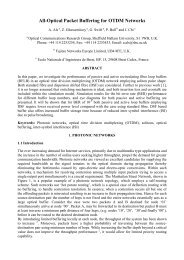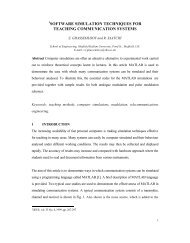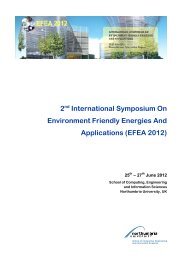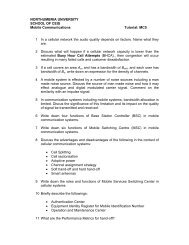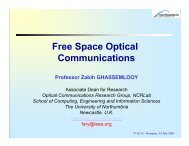Performance of sub-carrier modulated Free-Space Optical ...
Performance of sub-carrier modulated Free-Space Optical ...
Performance of sub-carrier modulated Free-Space Optical ...
You also want an ePaper? Increase the reach of your titles
YUMPU automatically turns print PDFs into web optimized ePapers that Google loves.
<strong>Performance</strong> <strong>of</strong> <strong>sub</strong>-<strong>carrier</strong> <strong>modulated</strong> FSO communication link 343<br />
Z. Ghassemlooy received his BSc in Electrical and Electronics Engineering<br />
from the Manchester Metropolitan University in 1981; an MSc and a PhD from<br />
the University <strong>of</strong> Manchester Institute <strong>of</strong> Science and Technology in 1984 and<br />
1987, respectively. From 1987 to 1988, he worked as a Post-Doctoral Research<br />
Fellow on optical sensors at the City University, London. He joined the<br />
Sheffield Hallam University as a Lecturer in 1988 and became a Pr<strong>of</strong>essor in<br />
1997. In 2004, he moved to the Northumbria University as an Associate Dean<br />
for research in the School <strong>of</strong> Computing, Engineering and Information<br />
Sciences. His research interests include: photonics networks, modulation<br />
techniques, high-speed optical systems, optical wireless communications and<br />
optical fibre sensors. He is a Chartered Engineer, a Fellow <strong>of</strong> IET and a Senior<br />
Member <strong>of</strong> IEEE.<br />
V. Ahmadi received his BSc in Electrical Engineering from the Sharif<br />
University <strong>of</strong> Technology, Tehran, Iran in 1985, and his MSc from the Tarbiat<br />
Modares University, Tehran, Iran in 1989, and his PhD from the Kyoto<br />
University, Kyoto, Japan in 1994 in Electronic Engineering–Optoelectronics.<br />
He joined the Tarbiat Modares University as an Assistant Pr<strong>of</strong>essor in 1994 and<br />
became a Pr<strong>of</strong>essor in 2006. He was the Head <strong>of</strong> the Semiconductor<br />
Department <strong>of</strong> Laser Research Centre, Tehran, Iran from 1994 to 2006. He<br />
became the Research Vice President <strong>of</strong> the Iran National Scientific Research<br />
Centre (1996–1997). His research interests include: quantum photonics devices,<br />
optical modulator and amplifiers, high-speed optical sources and detectors,<br />
optical microresonator active and passive devices, optical wireless<br />
communications and all optical switches.<br />
1 Introduction<br />
FSO communication systems as an alternative means <strong>of</strong> providing high bandwidth over a<br />
short to medium range links has seen a growing increase in research and development<br />
activities over the past few years. Increasing commercial deployment <strong>of</strong> the FSO could be<br />
said to be partly responsible for this surge in research activities (Willebrand and Ghuman,<br />
2002; Wilson et al., 2005). FSO is used in a number <strong>of</strong> applications including the cellular<br />
communication backhaul, optical fibre communications back-up links, exhibition halls<br />
and disaster recovery among other emerging applications (Willebrand and Ghuman,<br />
2002; Uysal, Li and Yu, 2006). However, <strong>of</strong> major concern in FSO systems is the<br />
dependence <strong>of</strong> its channel – the atmosphere – on the unpredictable weather conditions.<br />
Effects <strong>of</strong> fog, rain, atmospheric gases and aerosols result in beam attenuation due to<br />
photon absorption and scattering (Gagliardi and Karp, 1995).<br />
In dense fog conditions, laser radiations suffer prohibitive amount <strong>of</strong> attenuation<br />
limiting the FSO range to < 500 m in such conditions (Isaac, Kim and Korevaar, 2001).<br />
However, in clear atmosphere with low extinction coefficients, a longer range is easily<br />
achievable. In clear weather conditions, a primary factor that impairs the performance <strong>of</strong><br />
a FSO link is the random changes in atmospheric temperature. The temperature<br />
fluctuations depend on the speed <strong>of</strong> wind and the height above the ground <strong>of</strong> the<br />
traversing laser radiation (Osche, 2002).The resulting eddies/cells <strong>of</strong> varying sizes (from<br />
~0.1 to ~10 m) act like refractive prisms <strong>of</strong> varying index <strong>of</strong> refraction (Killinger, 2002).<br />
Consequently, a laser radiation traversing a turbulence atmosphere experiences random<br />
variation (fading) in its irradiance and phase. A familiar effect <strong>of</strong> turbulence is the




